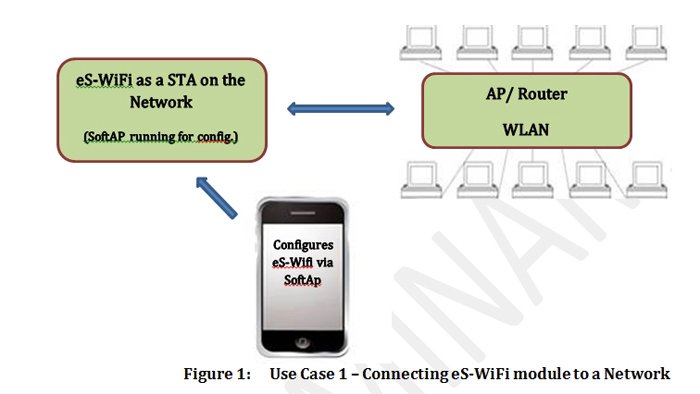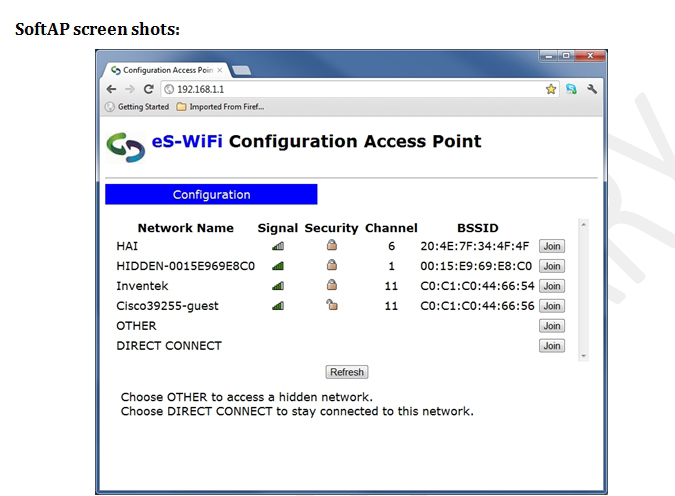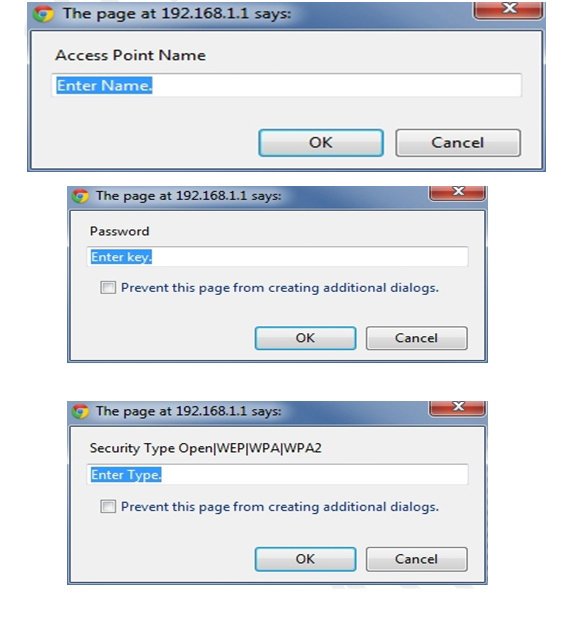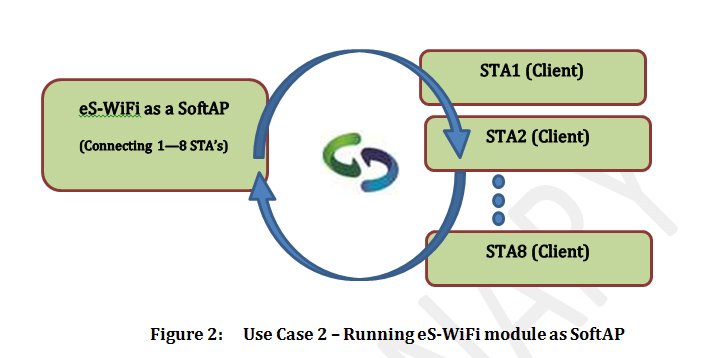The eS-WiFi family of module products has a powerful built in SoftAP function that allows customers to easily command the eS-WiFi module to join a network for the growing number of machine-to-machine (M2M) and Internet-of-Things (IoT) applications in the home and in the enterprise.
The SoftAP function can also be used as well for setting up setup peer-to-peer (P2P) networks and applications such as On-the-Go gaming. The module’s infrastructure mode AP allows both iOS and Android based devices to easily
The eS-WiFi modules are wireless LAN modules that are typically embedded into devices/appliances that connect to home networks, Wi-Fi hot spots, and workplace networks. These devices operate as a station (STA) which can connect to a single wireless router/access point (AP) that is typically hardwired at a fixed location.
The eS-WiFi family of 802.11 b/g/n modules have an embedded microcontroller running a fully integrated TCP/IP stack and a simple to use AT command set. One of the features described in this application note is the implementation of a Soft Access Point (SoftAP) technology which enables an eS-WiFi module to behave like a wireless AP.
SoftAP Overview
The Inventek eS-WiFi modules are offered with a complete TCP/IP stack and require only a simple AT command over the USB, UART or SPI interface to communicate with the module. In a typical embedded application, a simple 8/16/32 bit microcontroller is used to send the AT command to initiate a SoftAP. Once the AP is started other devices (users) can join the network and be connected as a client on that network.
Use cases of the SoftAP:
Use Case 1: Joining a Local Area Network using the SoftAP
You have an embedded product and you want to configure that product to join a network (See Figure 1). One way, to make this happen, is to have the eS-WiFi automatically power up as an Access Point.
The user can use a PC, tablet or any smartphone to view the AP and type in the SSID and Password. After the user, selects “Join” the Access Point is closed and the eS-WiFi module subsequently turns off the AP and joins the network as a client.

Following is the procedure required to implement this use case:
- Use the “A0” command to activate the SoftAP:
- i. Access Point is activated.
- ii. DHCP is activated.
- iii. Web server is activated.
- iv. DNS is activated.
- Select ” Join” on the Webpage to connect the eS-WiFi module to the selected network:
- i. Access Point shuts down.
- ii. DHCP shuts down.
- iii. DNS shuts down.
The module has now joined the selected network as a client/appliance device.

Note: There is also an AT command for changing the name of the Configuration Access Point to identify a specific customer product name or company name, e.g. change “Inventek” to “ABC Corp.”
The user also has the ability to manually enter the information to join a network as well.
SoftAP Manual Join screen shots:

Use Case 2: Direct Connection to the SoftAP
You have embedded the eS-WiFi module into a printer system or interface box and configured it as a SoftAP that allows smartphones/ PC’s and other devices to make a “Direct Connection” via the eS-WiFi SoftAP function (See Figure 2). The SoftAP enables file transfers, file sharing, printing, and information exchange between as many as 8 clients (STAs). This is all accomplished without the use of a fixed AP.
One way to facilitate this senario is to have the eS-WiFi automatically power up as a SoftAP that a user can view using a PC or any smartphone and selects “Direct Connect” on the eS-WiFi SoftAP web server. As soon as the user selects “Direct Connect” the Access Point remains running and the client (STA) is connected to the eS-WiFi SoftAP. This allows WLAN devices to easily connect without the need for a fixed AP and supports WiFi M2M communication and ON-The-GO connections for printing and file sharing.

Figure 2: Use Case 2 – Running eS-WiFi module as SoftAP
Following is the procedure required to implement this use case:
- Use the “A0” command to activate the SoftAP:
- i. Access Point is activated.
- ii. DHCP is activated.
- iii. Web server is activated.
- iv. DNS is activated.
- User selects ” Direct Connect” on the broadcasted Webpage:
- i. Access Point continues to run and manage the SoftAP.
- ii. DHCP continues to run.
- iii. Web server is shutdown, but SoftAP remains visible.
Multiple clients may now connect to the SoftAP.
In summary the “Direct Connection” allows the embedded eS-WiFi to run as a SoftAp with the following capabilities:
- Supports Client-to-Client (M2M) connections.
- Supports Client-to-Device/Appliance connections.
- Supports Eight Simultaneous Connections.
- Full interoperability.
4.0 SoftAP Features Summary
|
Feature |
Description |
|
Stations Supported |
ISM4319 – Two ISM43362 – Five |
|
SSID Broadcast |
Yes |
|
DHCP |
Yes |
|
Security |
Open (WEP /WPA-PSK in development) |